radiator SKODA ROOMSTER 2006 1.G Owner's Manual
[x] Cancel search | Manufacturer: SKODA, Model Year: 2006, Model line: ROOMSTER, Model: SKODA ROOMSTER 2006 1.GPages: 274, PDF Size: 48.64 MB
Page 114 of 274
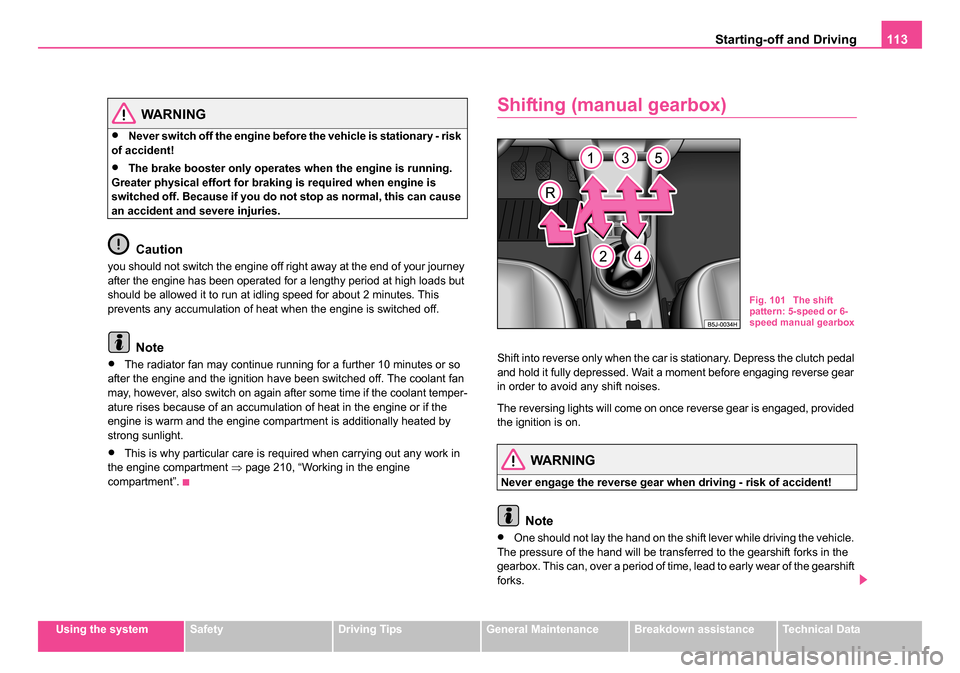
Starting-off and Driving113
Using the systemSafetyDriving TipsGeneral MaintenanceBreakdown assistanceTechnical Data
WARNING
•Never switch off the engine before the vehicle is stationary - risk
of accident!
•The brake booster only operates when the engine is running.
Greater physical effort for brakin g is required when engine is
switched off. Because if you do not stop as normal, this can cause
an accident and severe injuries.
Caution
you should not switch the engine off right away at the end of your journey
after the engine has been operated for a lengthy period at high loads but
should be allowed it to run at idling speed for about 2 minutes. This
prevents any accumulation of heat when the engine is switched off.
Note
•The radiator fan may continue running for a further 10 minutes or so
after the engine and the ignition have been switched off. The coolant fan
may, however, also switch on again after some time if the coolant temper-
ature rises because of an accumulation of heat in the engine or if the
engine is warm and the engine compartment is additionally heated by
strong sunlight.
•This is why particular care is required when carrying out any work in
the engine compartment ⇒page 210, “Working in the engine
compartment”.
Shifting (manual gearbox)
Shift into reverse only when the car is stationary. Depress the clutch pedal
and hold it fully depressed. Wait a moment before engaging reverse gear
in order to avoid any shift noises.
The reversing lights will come on once reverse gear is engaged, provided
the ignition is on.
WARNING
Never engage the reverse gear when driving - risk of accident!
Note
•One should not lay the hand on the shift lever while driving the vehicle.
The pressure of the hand will be transferred to the gearshift forks in the
gearbox. This can, over a period of time, lead to early wear of the gearshift
forks.
Fig. 101 The shift
pattern: 5-speed or 6-
speed manual gearbox
NKO 20 A05.book Page 113 Wednesday, June 21, 2006 1:42 PM
Page 210 of 274
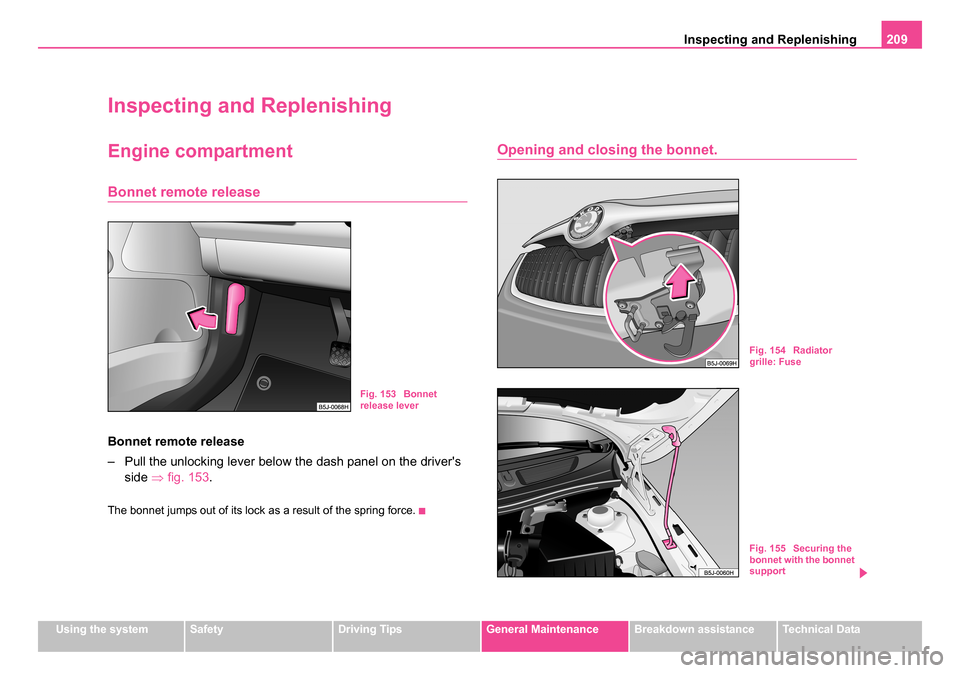
Inspecting and Replenishing209
Using the systemSafetyDriving TipsGeneral MaintenanceBreakdown assistanceTechnical Data
Inspecting and Replenishing
Engine compartment
Bonnet remote release
Bonnet remote release
– Pull the unlocking lever below the dash panel on the driver's
side ⇒fig. 153 .
The bonnet jumps out of its lock as a result of the spring force.
Opening and closing the bonnet.
Fig. 153 Bonnet
release lever
Fig. 154 Radiator
grille: Fuse
Fig. 155 Securing the
bonnet with the bonnet
support
NKO 20 A05.book Page 209 Wednesday, June 21, 2006 1:42 PM
Page 212 of 274
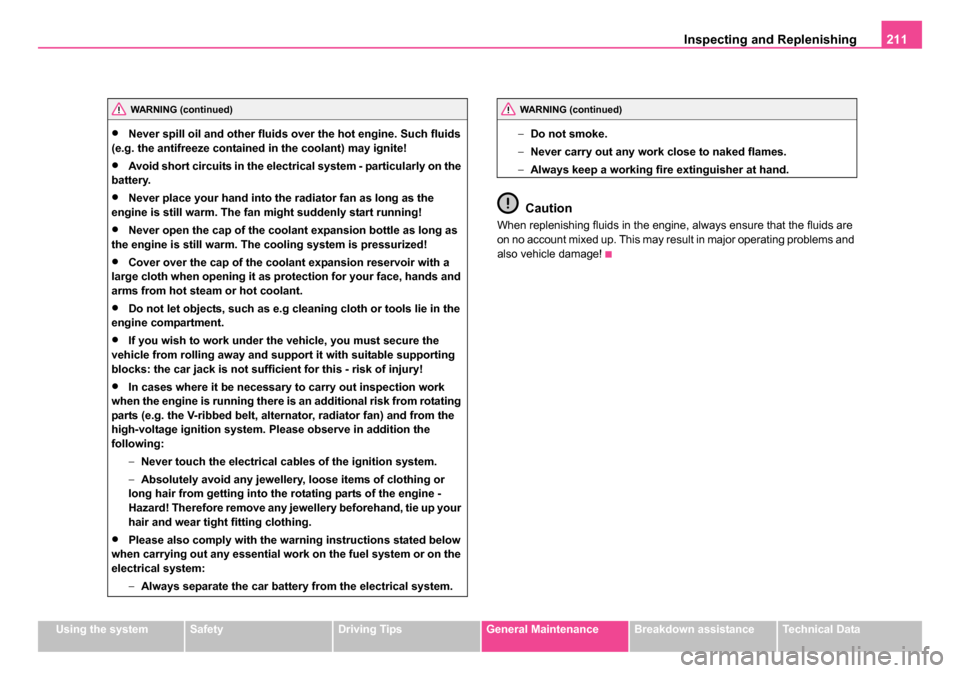
Inspecting and Replenishing211
Using the systemSafetyDriving TipsGeneral MaintenanceBreakdown assistanceTechnical Data
•Never spill oil and other fluids over the hot engine. Such fluids
(e.g. the antifreeze contained in the coolant) may ignite!
•Avoid short circuits in the electrical system - particularly on the
battery.
•Never place your hand into the radiator fan as long as the
engine is still warm. The fan might suddenly start running!
•Never open the cap of the coolant expansion bottle as long as
the engine is still warm. The cooling system is pressurized!
•Cover over the cap of the coolant expansion reservoir with a
large cloth when opening it as protection for your face, hands and
arms from hot steam or hot coolant.
•Do not let objects, such as e.g cleaning cloth or tools lie in the
engine compartment.
•If you wish to work under the vehicle, you must secure the
vehicle from rolling away and support it with suitable supporting
blocks: the car jack is not sufficient for this - risk of injury!
•In cases where it be necessary to carry out inspection work
when the engine is running there is an additional risk from rotating
parts (e.g. the V-ribbed belt, alternator, radiator fan) and from the
high-voltage ignition system. Please observe in addition the
following:
−Never touch the electrical cables of the ignition system.
− Absolutely avoid any jewellery, loose items of clothing or
long hair from getting into the rotating parts of the engine -
Hazard! Therefore remove any jewellery beforehand, tie up your
hair and wear tight fitting clothing.
•Please also comply with the warning instructions stated below
when carrying out any essential work on the fuel system or on the
electrical system:
−Always separate the car battery from the electrical system. −
Do not smoke.
− Never carry out any work close to naked flames.
− Always keep a working fi re extinguisher at hand.
Caution
When replenishing fluids in the engine, always ensure that the fluids are
on no account mixed up. This may result in major operating problems and
also vehicle damage!
WARNING (continued)WARNING (continued)
NKO 20 A05.book Page 211 Wednesday, June 21, 2006 1:42 PM
Page 219 of 274
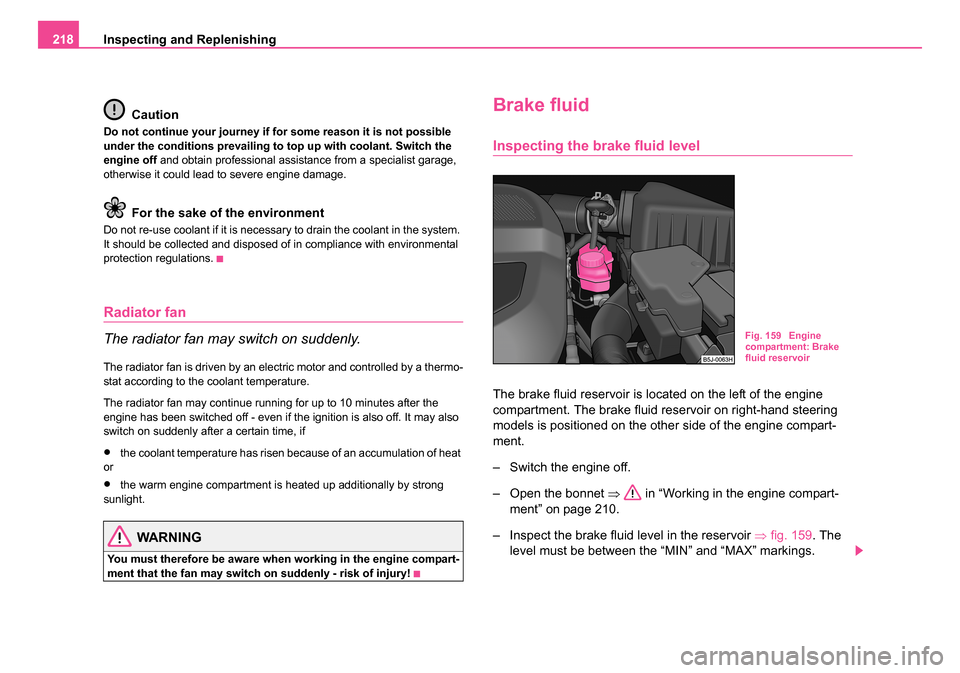
Inspecting and Replenishing
218
Caution
Do not continue your journey if for some reason it is not possible
under the conditions prevailing to top up with coolant. Switch the
engine off and obtain professional assistance from a specialist garage,
otherwise it could lead to severe engine damage.
For the sake of the environment
Do not re-use coolant if it is necessary to drain the coolant in the system.
It should be collected and disposed of in compliance with environmental
protection regulations.
Radiator fan
The radiator fan may switch on suddenly.
The radiator fan is driven by an electric motor and controlled by a thermo-
stat according to the coolant temperature.
The radiator fan may continue running for up to 10 minutes after the
engine has been switched off - even if the ignition is also off. It may also
switch on suddenly after a certain time, if
•the coolant temperature has risen because of an accumulation of heat
or
•the warm engine compartment is heated up additionally by strong
sunlight.
WARNING
You must therefore be aware when working in the engine compart-
ment that the fan may switch on suddenly - risk of injury!
Brake fluid
Inspecting the brake fluid level
The brake fluid reservoir is located on the left of the engine
compartment. The brake fluid reservoir on right-hand steering
models is positioned on the other side of the engine compart-
ment.
– Switch the engine off.
– Open the bonnet ⇒ in “Working in the engine compart-
ment” on page 210.
– Inspect the brake fluid level in the reservoir ⇒fig. 159 . The
level must be between the “MIN” and “MAX” markings.
Fig. 159 Engine
compartment: Brake
fluid reservoir
NKO 20 A05.book Page 218 Wednesday, June 21, 2006 1:42 PM
Page 225 of 274
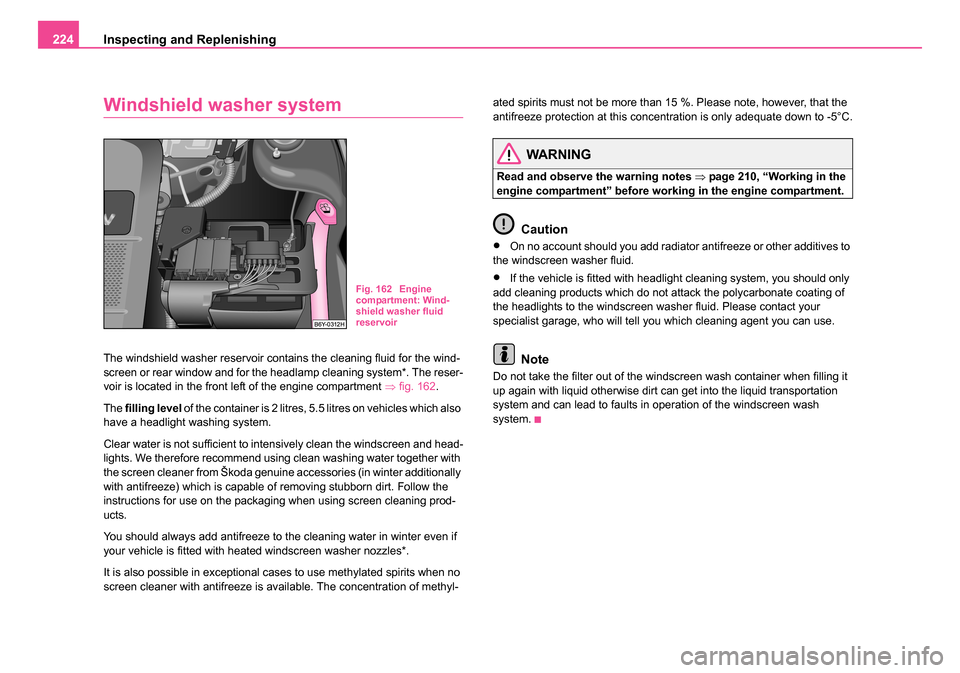
Inspecting and Replenishing
224
Windshield washer system
The windshield washer reservoir contains the cleaning fluid for the wind-
screen or rear window and for the headlamp cleaning system*. The reser-
voir is located in the front left of the engine compartment ⇒fig. 162 .
The filling level of the container is 2 litres, 5.5 litres on vehicles which also
have a headlight washing system.
Clear water is not sufficient to intensively clean the windscreen and head-
lights. We therefore recommend using clean washing water together with
the screen cleaner from Škoda genuine accessories (in winter additionally
with antifreeze) which is capable of removing stubborn dirt. Follow the
instructions for use on the packaging when using screen cleaning prod-
ucts.
You should always add antifreeze to the cleaning water in winter even if
your vehicle is fitted with heated windscreen washer nozzles*.
It is also possible in exceptional cases to use methylated spirits when no
screen cleaner with antifreeze is available. The concentration of methyl- ated spirits must not be more than 15 %. Please note, however, that the
antifreeze protection at this concentration is only adequate down to -5°C.
WARNING
Read and observe the warning notes
⇒page 210, “Working in the
engine compartment” before working in the engine compartment.
Caution
•On no account should you add radiator antifreeze or other additives to
the windscreen washer fluid.
•If the vehicle is fitted with headlight cleaning system, you should only
add cleaning products which do not attack the polycarbonate coating of
the headlights to the windscreen washer fluid. Please contact your
specialist garage, who will tell you which cleaning agent you can use.
Note
Do not take the filter out of the windscreen wash container when filling it
up again with liquid otherwise dirt can get into the liquid transportation
system and can lead to faults in operation of the windscreen wash
system.
Fig. 162 Engine
compartment: Wind-
shield washer fluid
reservoir
NKO 20 A05.book Page 224 Wednesday, June 21, 2006 1:42 PM
Page 254 of 274
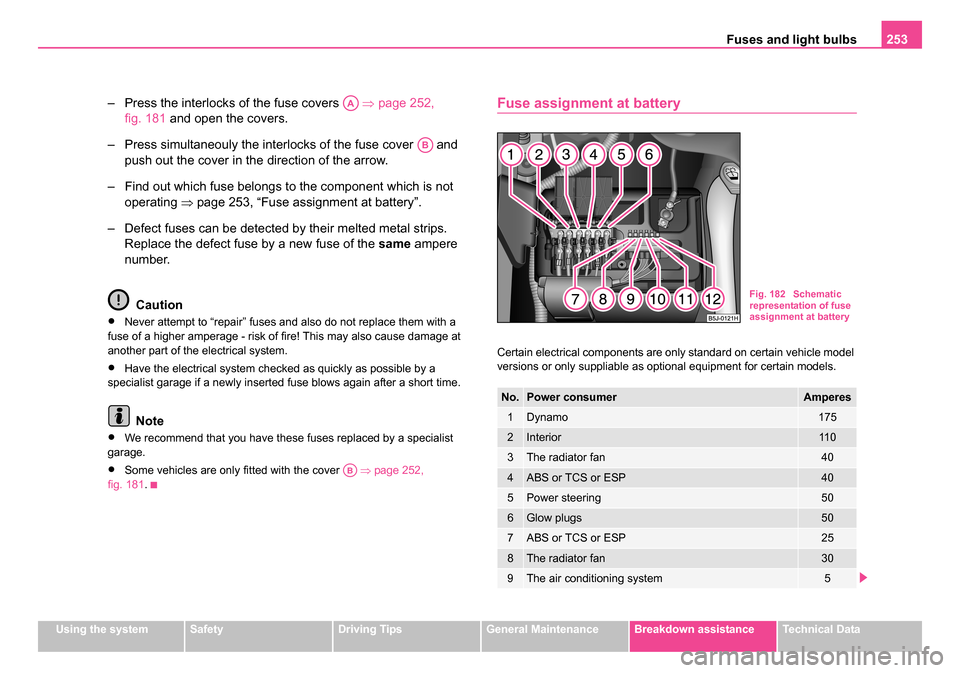
Fuses and light bulbs253
Using the systemSafetyDriving TipsGeneral MaintenanceBreakdown assistanceTechnical Data
– Press the interlocks of the fuse covers ⇒page 252,
fig. 181 and open the covers.
– Press simultaneouly the interlocks of the fuse cover and push out the cover in the direction of the arrow.
– Find out which fuse belongs to the component which is not operating ⇒page 253, “Fuse assignment at battery”.
– Defect fuses can be detected by their melted metal strips. Replace the defect fuse by a new fuse of the same ampere
number.
Caution
•Never attempt to “repair” fuses and also do not replace them with a
fuse of a higher amperage - risk of fire! This may also cause damage at
another part of the electrical system.
•Have the electrical system checked as quickly as possible by a
specialist garage if a newly inserted fuse blows again after a short time.
Note
•We recommend that you have these fuses replaced by a specialist
garage.
•Some vehicles are only fitted with the cover ⇒page 252,
fig. 181 .
Fuse assignment at battery
Certain electrical components are only standard on certain vehicle model
versions or only suppliable as optional equipment for certain models.
AA
AB
AB
No.Power consumerAmperes
1Dynamo175
2Interior11 0
3The radiator fan40
4ABS or TCS or ESP40
5Power steering50
6Glow plugs50
7ABS or TCS or ESP25
8The radiator fan30
9The air conditioning system5
Fig. 182 Schematic
representation of fuse
assignment at battery
NKO 20 A05.book Page 253 Wednesday, June 21, 2006 1:42 PM
Page 270 of 274
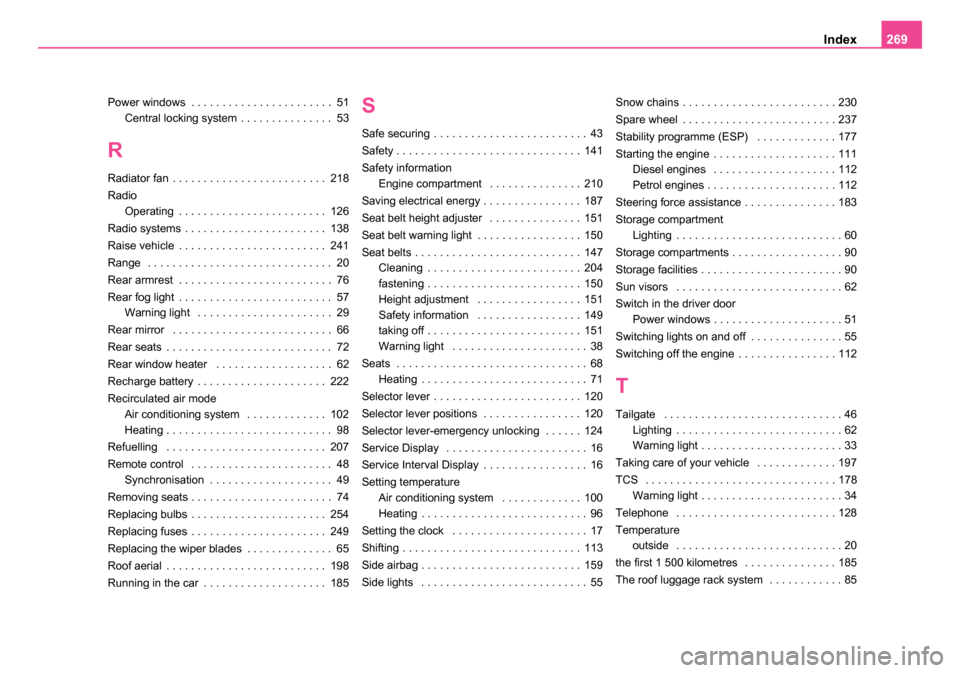
Index269
Power windows . . . . . . . . . . . . . . . . . . . . . . . 51
Central locking system . . . . . . . . . . . . . . . 53
R
Radiator fan . . . . . . . . . . . . . . . . . . . . . . . . . 218
RadioOperating . . . . . . . . . . . . . . . . . . . . . . . . 126
Radio systems . . . . . . . . . . . . . . . . . . . . . . . 138
Raise vehicle . . . . . . . . . . . . . . . . . . . . . . . . 241
Range . . . . . . . . . . . . . . . . . . . . . . . . . . . . . . 20
Rear armrest . . . . . . . . . . . . . . . . . . . . . . . . . 76
Rear fog light . . . . . . . . . . . . . . . . . . . . . . . . . 57 Warning light . . . . . . . . . . . . . . . . . . . . . . 29
Rear mirror . . . . . . . . . . . . . . . . . . . . . . . . . . 66
Rear seats . . . . . . . . . . . . . . . . . . . . . . . . . . . 72
Rear window heater . . . . . . . . . . . . . . . . . . . 62
Recharge battery . . . . . . . . . . . . . . . . . . . . . 222
Recirculated air mode Air conditioning system . . . . . . . . . . . . . 102
Heating . . . . . . . . . . . . . . . . . . . . . . . . . . . 98
Refuelling . . . . . . . . . . . . . . . . . . . . . . . . . . 207
Remote control . . . . . . . . . . . . . . . . . . . . . . . 48 Synchronisation . . . . . . . . . . . . . . . . . . . . 49
Removing seats . . . . . . . . . . . . . . . . . . . . . . . 74
Replacing bulbs . . . . . . . . . . . . . . . . . . . . . . 254
Replacing fuses . . . . . . . . . . . . . . . . . . . . . . 249
Replacing the wiper blades . . . . . . . . . . . . . . 65
Roof aerial . . . . . . . . . . . . . . . . . . . . . . . . . . 198
Running in the car . . . . . . . . . . . . . . . . . . . . 185
S
Safe securing . . . . . . . . . . . . . . . . . . . . . . . . . 43
Safety . . . . . . . . . . . . . . . . . . . . . . . . . . . . . . 141
Safety information Engine compartment . . . . . . . . . . . . . . . 210
Saving electrical energy . . . . . . . . . . . . . . . . 187
Seat belt height adjuster . . . . . . . . . . . . . . . 151
Seat belt warning light . . . . . . . . . . . . . . . . . 150
Seat belts . . . . . . . . . . . . . . . . . . . . . . . . . . . 147 Cleaning . . . . . . . . . . . . . . . . . . . . . . . . . 204
fastening . . . . . . . . . . . . . . . . . . . . . . . . . 150
Height adjustment . . . . . . . . . . . . . . . . . 151
Safety information . . . . . . . . . . . . . . . . . 149
taking off . . . . . . . . . . . . . . . . . . . . . . . . . 151
Warning light . . . . . . . . . . . . . . . . . . . . . . 38
Seats . . . . . . . . . . . . . . . . . . . . . . . . . . . . . . . 68 Heating . . . . . . . . . . . . . . . . . . . . . . . . . . . 71
Selector lever . . . . . . . . . . . . . . . . . . . . . . . . 120
Selector lever positions . . . . . . . . . . . . . . . . 120
Selector lever-emergency unlocking . . . . . . 124
Service Display . . . . . . . . . . . . . . . . . . . . . . . 16
Service Interval Display . . . . . . . . . . . . . . . . . 16
Setting temperature Air conditioning system . . . . . . . . . . . . . 100
Heating . . . . . . . . . . . . . . . . . . . . . . . . . . . 96
Setting the clock . . . . . . . . . . . . . . . . . . . . . . 17
Shifting . . . . . . . . . . . . . . . . . . . . . . . . . . . . . 113
Side airbag . . . . . . . . . . . . . . . . . . . . . . . . . . 159
Side lights . . . . . . . . . . . . . . . . . . . . . . . . . . . 55 Snow chains . . . . . . . . . . . . . . . . . . . . . . . . . 230
Spare wheel . . . . . . . . . . . . . . . . . . . . . . . . . 237
Stability programme (ESP) . . . . . . . . . . . . . 177
Starting the engine . . . . . . . . . . . . . . . . . . . . 111
Diesel engines . . . . . . . . . . . . . . . . . . . . 112
Petrol engines . . . . . . . . . . . . . . . . . . . . . 112
Steering force assistance . . . . . . . . . . . . . . . 183
Storage compartment Lighting . . . . . . . . . . . . . . . . . . . . . . . . . . . 60
Storage compartments . . . . . . . . . . . . . . . . . . 90
Storage facilities . . . . . . . . . . . . . . . . . . . . . . . 90
Sun visors . . . . . . . . . . . . . . . . . . . . . . . . . . . 62
Switch in the driver door Power windows . . . . . . . . . . . . . . . . . . . . . 51
Switching lights on and off . . . . . . . . . . . . . . . 55
Switching off the engine . . . . . . . . . . . . . . . . 112
T
Tailgate . . . . . . . . . . . . . . . . . . . . . . . . . . . . . 46 Lighting . . . . . . . . . . . . . . . . . . . . . . . . . . . 62
Warning light . . . . . . . . . . . . . . . . . . . . . . . 33
Taking care of your vehicle . . . . . . . . . . . . . 197
TCS . . . . . . . . . . . . . . . . . . . . . . . . . . . . . . . 178 Warning light . . . . . . . . . . . . . . . . . . . . . . . 34
Telephone . . . . . . . . . . . . . . . . . . . . . . . . . . 128
Temperature outside . . . . . . . . . . . . . . . . . . . . . . . . . . . 20
the first 1 500 kilometres . . . . . . . . . . . . . . . 185
The roof luggage rack system . . . . . . . . . . . . 85
NKO 20 A05.book Page 269 Wednesday, June 21, 2006 1:42 PM